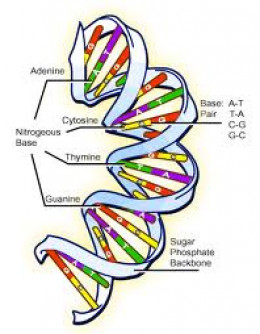Why are we coloured?
Why are we coloured?
The world is made up of different coloured people, we have yellow, red, whites and blacks.
Science says pigments, which is true, but can it explain why? I still believe the bible, but I want to know what other people think.From my very old-fashioned learning I was told that the world has three basic human types: negroid, mongoloid and caucasian. Let us take for example the first of these - and this would apply to the others as well - the negroid are the people, basically from Africa who were commonly called negroes or, as they now prefer, black people. They are now living, as we know, in many parts of the world.
Of course, negroes are not black. They come in varying degrees of shade, some are very light-coloured indeed. For example, the descendants of the black people who settled in Massachesetts and the Northeastern States of America are pale indeed compared with those who live in, say, Senegal or the Congo. Skin pigments of melanin (I might not have spelled that correctly) are in everyone's skin. Nature allows it to develop more in people who are exposed to lots of strong sunshine. But where the sun is weaker, this is gradually 'bred out.' It is a process of natural evolution taking place over just a generation or two.
So you could say that most black people come in varying shades from very light brown through to almost a deep almost black. However, because they're all of negroid stock, they can all claim to be black.
The coppery colour of American Red Indians would also vary. The Innuits of Northern Canada would be of a different hue, I imagine, than those who live in Arizona and New Mexico. The further from the tropics, the lighter the hue.
Caucasians -so called whites - can range from the dark colours of people living in tropical India to those who have the alabaster skin of someone from the north of Scandivia.
So, to get back: three basic human types, dark or lighter conditioned over time by where they live as far as their continued exposure to sunshine.
Make sense?I won't get into a creation vs. evolution debate. But we do know that one aspect skin color is adaptive. People absorb Vitamin D from sunshine. But excessive sunshine brings a risk of skin cancer. People who live in sunnier climes tend to have darker skin. The melatonin in the darker skin protects people against skin cancer, but it also reduces the rate of creation of Vitamin D from sunlight.
We see this independent of the three races (caucasian, negroid, asiatic). Native Americans from the SouthWest and Central America are darker than those in Alaska; Southern Chinese are darker than Northern Chinese, Southern Italians are darker than Swedes. (By darker, I simply mean, have more melatonin in their skin at a given level of exposure to sunlight.)
So, one practical answer to the word "why" is that such coloration maximizes health for the local climate by providing enough Vitamin D while reducing the risk of skin cancer.- JThomp42posted 12 years ago
0
The concept of “race” is biological, not Biblical. There is no mention of different races, as such, in the Bible, nor even of the very concept of a “race.” Evidently, there is no Biblical or theological meaning to the term, and we must conclude, therefore, that races are purely arbitrary entities invented by man for his own convenience in biological and anthropological studies.
Biologically a race is generally thought of as a variety, or sub-species, within a given species. In terms of evolutionary philosophy, it may represent a stage in the evolution of a new species. Thus different sub-species within a species may vary in their respective degrees of evolutionary advance over the ancestral species, depending upon the relative efficiencies with which the postulated evolutionary mechanisms of mutation, segregation, natural selection, etc., have been functioning in each case.JThomp, I disagree with your 2nd para. In scientific biology, there is no idea "more advanced" evolution. Each subspecies (race) is differently adapted, but none is more advanced than another. The notion more advanced is a holdover from 19th century.
Good debate.. Appreciate the interaction here..
From what I've read, skin color varies due to the ability of human beings to adapt to their environment. For example, people with dark skin have dark skin because they come from very hot, sunny areas of the world and having dark skin protects their bodies from the sun.
Very pale, blonde people historically come from cold countries with little sun, so their light skin allows them to soak up as much of the sun's rays as possible to keep them healthy.
As races intermix, genetics cause skin tones to vary, so, for example, the child of one black parent and one asian parent is more likely to have lighter skin than a child born of two black parents. However, this is not a given. Awhile back there was a big news story about a black couple from Africa that gave birth to a blonde haired blue eyed baby!All of those answers are true and right, but i'm going to add this one...so that we can taste the rainbow like skittles haha seriously-color makes the world a funner less boring place!
Up to 75k years ago all humans were Black African. Continuous migrations out of Africa took them as far as northern Europe and Asia where they were trapped by the last ice age and had to dwell deep in caves for survival. Unnatural conditions and behavior along with a lack of sunlight caused them to lose the Melanin in their skin and hair, similar to Albinoism. Further interbreeding among the various tribes (yes Africans have the most diverse DNA traits of any race) created the different races. The ability to produce Melatonin also contributes to the stability of DNA codons in preventing genetic drift.
I quite don't get it..can you elaborate more.

from the DNA construct in each human that provides the body breakdown-- khmohsinposted 12 years ago
0
Human skin colour can range from almost black to pinkish white in different people. In general, people with ancestors from sunny regions have darker skin than people with ancestors from regions with less sunlight.
Skin colour is determined by the amount and type of the pigment melanin in the skin. Melanin comes in two types: phaeomelanin (red to yellow) and eumelanin (dark brown to black). Both amount and type are determined by four to six genes which operate under incomplete dominance. One copy of each of those genes is inherited from the father and one from the mother. Each gene comes in several alleles, resulting in a great variety of different skin colours.
Related Discussions
- 96
Why Do Men Prefer Light-Skinned Women? Do Women Think Light-Skinned Men Are More
by ngureco 7 years ago
I think everyone has there own preferences, You would think people prefer dark skin that's why they are out in the sun and at the tanning beds Always striving to look better, but not striving to be better people.
- 17
How many minutes a day is recommended for tanning/sunbathing?
by ii3rittles 12 years ago
How many minutes a day is recommended for tanning/sunbathing?I'm doing one hour most days. I don't burn and I use coconut oil for sunblock/tanning oil.
- 2342
Why can't people discuss race in a productive manner?
by G. Diane Nelson Trotter 8 years ago
I changed from question to forum to allow commenters to have more space to express their opinions. I initiated the question, and now forum, to discuss reactions to Michelle Obama's statement at the DNC. Her words: “I wake up every morning in a house that was built by...
- 31
Black People are All Shades And Colors So, What Makes A Black Person Black?
by VC L Veasey 11 years ago
Black People are All Shades And Colors So, What Makes A Black Person Black?
- 45
Skin whitening cream - Is is healthy? Is it moral?
by 2patricias 15 years ago
We use Google Ads on our website (www.looklovely.net) which are fed to the site according to contens. We are happy with these ads at least 98% of the time, but we are concerned about ads for skin whitening cream. As a result, we use the facility that allows us to block these ads.Our...
- 46
What is the MAIN underlying reason of racism towards Black people, particularly
by Grace Marguerite Williams 10 years ago
What is the MAIN underlying reason of racism towards Black people, particularly Black men?















